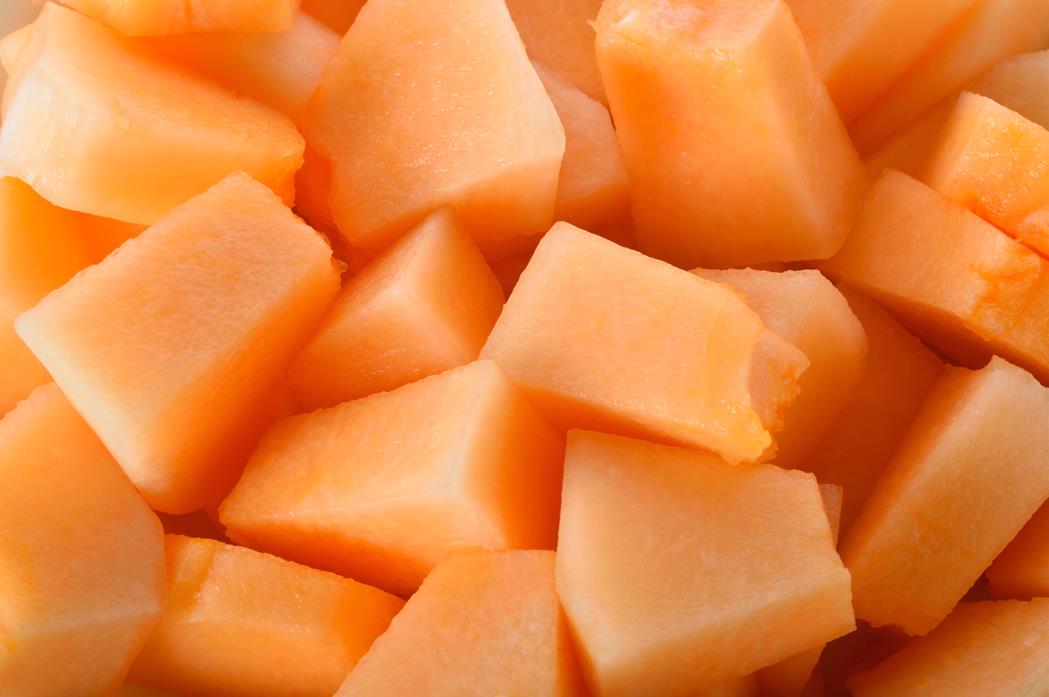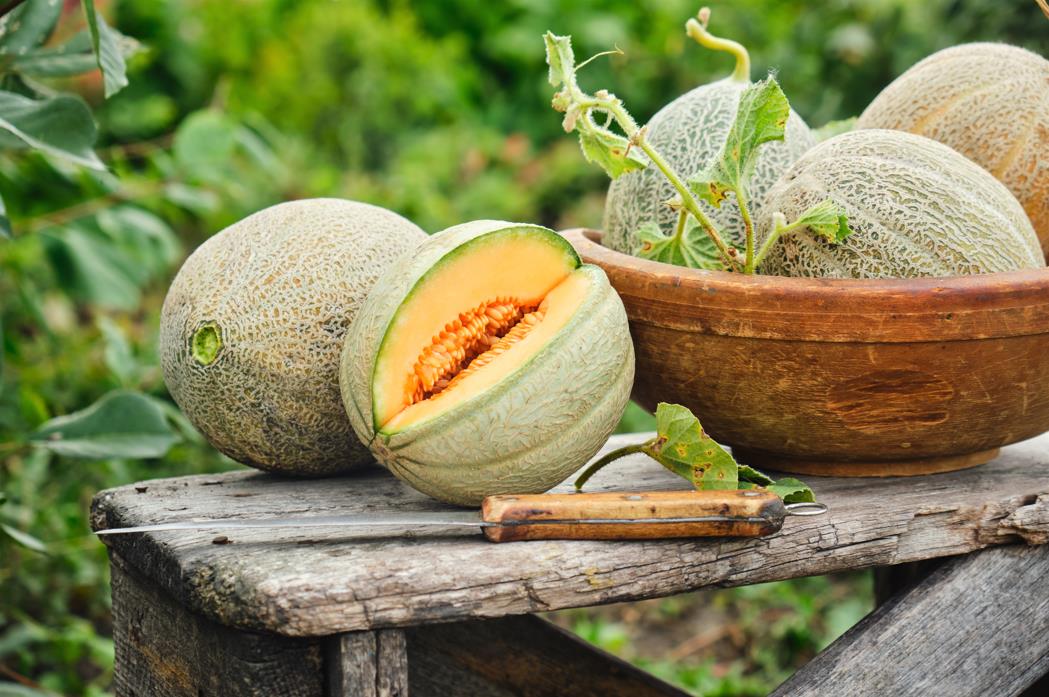Cantaloupe is summer’s gift and known as ‘the flavor of sunshine’. Fragrant and juicy, loaded with musky melon sweetness, it’s many people’s go-to fruit when temperatures rise.
In this HDMD Knives article, we’re going to be looking more closely at cantaloupe – knife skills for cutting and slicing cantaloupe, prepping it properly for eating, and its benefits to your health.
Table of contents
Initial prep
First things first. Cantaloupe and other melons can harbor harmful bacteria on the skin, so good hygiene practices are important.
When handling raw fruit with your hands, always wash your hands well first.
Take your cantaloupe and rinse it well under cool running water to get rid of any dirt on its surface. Then take a clean bristle brush/scrubbing brush and scrub the whole surface of the cantaloupe skin lightly but thoroughly all over. You don’t need detergent; the running water is enough on its own.
Rinse the cantaloupe when you’re done and dry it off with paper towels or a clean kitchen cloth. Now be sure to store the cantaloupe in your refrigerator at a cold temperature until you’re ready to use it.
How to cut a cantaloupe
We’re going to guide you through cutting cantaloupe into wedges, slices, and cubes, but first let’s assemble our tools. You’ll need:
- Your ripe cantaloupe
- A chopping /cutting board
- A sharp paring or utility knife
- A bowl to put the prepared cantaloupe into, this helps to keep your chopping surface clear
Handpicked for you
True cutting power in the palm of your hand
If your chopping board isn’t well adhered to your work surface and slides around, place a damp dish towel underneath it, this will secure it and allow you to use the knife safely.
Cutting a cantaloupe into wedges

Start off with your washed and dried cantaloupe on your chopping board in front of you. Because of its shape, the cantaloupe will tend to roll around, so a firm grip on the cantaloupe with your non – cutting hand is important here.
- If you want, cut about ½ inch off each end of the cantaloupe, this will flatten the ends of the fruit and you can balance it on either end without it rolling around.
- Cut the cantaloupe in half, from top to bottom. You’re going to make a straight cut down the side of the melon, right in the middle. Cutting the melon down the center will give you two halves of melon.
- With a large non-bendable spoon, you’re going to scoop out the seeds and pith matter from each half of the melon and discard these. Now you have two halves of cantaloupe, seedless and with the pith removed.
- Place each half of the cantaloupe face down on your chopping board, so that the skin is uppermost.
- Cut each half vertically along its middle, dividing it into 2. This will give you 2 large wedges of melon per melon half.
- If you want the cantaloupe wedges thinner, you’re going to cut the large wedges in half again, giving you 4 wedges. For very skinny wedges, cut each wedge vertically in half again to give you 8 wedges.
- At this stage you might want to remove the rind of the melon. To do so, take a sharp paring knife and holding each wedge either carefully in your hand or leaving it on the cutting board, you’re going to ease the paring knife through and between the tough rind and the flesh of the cantaloupe.
- Work slowly and carefully so that you divide the flesh and rind of the cantaloupe without waste, following the green area between the rind and the orange flesh of the fruit as your visual guide.
- Discard the rinds of the cantaloupe or put them into your compost heap as they’re not pleasant to eat but ecologically useful as compost matter.
Cutting a cantaloupe into slices

- Take your whole cantaloupe melon, and ‘top and tail’ it – cut ½ inch off both ends of its ‘globe’ so that the ends are now flattened.
- Place the melon securely on a flattened end, and using your chef’s knife, cut down the sides of the melon vertically from top to bottom, removing the rind but not taking off the orange flesh.
- Go around the cantaloupe, turning it as you go and cutting vertically down the sides, following its curve, so that you’re cutting off the rind in long strips.
- Once you’ve removed all the rind from the cantaloupe, discard this.
- Now, cut your peeled cantaloupe ball into half straight through the middle equator.
- Remove the seeds and pith with a spoon and discard.
- You now have two halves of a cantaloupe with the rind and seeds removed.
- Place each half of the cantaloupe face side down on your chopping board, the side with the seed cavity will be on the board in other words.
- Now using your chef’s knife, you’re going to slice through the cantaloupe half vertically in small increments. The wider apart your slices, the thicker the slices will be.
- Continue slicing until each half of the cantaloupe is divided into either thick or thinner slices, as you prefer.
For the purposes of presentation, you can gently scoop up a ‘fan’ of the slices with the side of your knife and arrange these on a serving plate fanned out and looking chic!
Cutting a cantaloupe into chunks/blocks

Cantaloupe cut into chunks is yum in fruit salads or desserts and very easy to achieve. Here’s how –
Remove the rind, seeds and pith from your cantaloupe as described in the steps before, and follow the instructions given for cutting the skinless melon into slices.
Place your skinless slices of melon in front of you on the chopping board lengthways/horizontally, and using your knife, cut vertically along the slices in increments. This will give you squarish, bite size blocks or chunks of melon to eat as is or to process down further into something like fruit juice or a health-giving smoothie.
Shop like a pro for cantaloupe
We like to see our readers get the most out of their produce dollar, so let’s look at some buying tips for cantaloupe:
- Avoid fruit with cracked or bruised skin and feel all around the cantaloupe with your fingers – there should be no soft spots or wetness seeping through the skin
- As with all fruit, a cantaloupe should feel heavy relative to its size – this means that it’s healthy and packed full of tasty juice
- Cantaloupe rind should be dull, not shiny. A dull rind means that the fruit is ripe and ready to be eaten.
- No part of the stem should still be attached to the melon. When a melon is ripe the stem will drop off completely, so a stem still attached means that the fruit was harvested too soon.
- When tapped with your knuckles, cantaloupe should make a hollow sound, that’s an indication that it’s ripe enough to eat!
The health benefits of cantaloupe

Cantaloupe is an excellent source of Vitamin C – an essential vitamin that is used by the body to grow, develop, and repair body tissues. Vitamin C is also an antioxidant, which means that it helps you to fight off damage from free radicals like pollution, smoking, or unhealthy fried foods.
Cantaloupe also contains both soluble and insoluble fiber – this wonder ingredient ensures a clean and properly working digestive system.
Cantaloupe FAQs
When is cantaloupe in season?
In the Western hemisphere, cantaloupe season runs from June through till August, the summer months. In warmer climates the season can last until October.
Are cantaloupe seeds edible?
Yes! And they’re delicious and good for you too. Simply rinse off your cantaloupe seeds, removing all fruit flesh and pith matter. Next, dry them thoroughly by patting dry with a kitchen towel or leaving them overnight to dry on a plate.
Heat your oven to 425F and spread the seeds out on a foil lined baking sheet in a single layer. Dress the seeds with a teaspoon of oil and add salt and other seasonings you like. Put another layer of foil over the seeds and tray as the seeds may ‘pop’ just like popcorn. Roast for about 5 minutes in the oven until they’re golden brown in color and enjoy as a crunchy snack or sprinkled on top of soups or salads.
How do I store cantaloupe for best freshness?
Cantaloupe can be left sitting out on the counter for about a week but if you live in a warmer climate, it’s best kept in the fridge for longevity.
To freeze cantaloupe, remove the rind, seeds and pith and cut into pieces. Place these pieces on a baking sheet in a single layer and put the tray into the freezer for 2 or 3 hours. Once the fruit has frozen solid, remove it carefully from the baking sheet and store it in a tightly sealed container in the freezer. Cantaloupe will last at least 3 months stored like this.
In conclusion
Cantaloupe is a winner for summer eating and healthy enjoyment. This article on cutting, prepping, and enjoying cantaloupe has hopefully inspired you to pick one up the next time you’re at your grocer!
Until we meet again dear reader, stay safe, stay well fed, and may the melons be with you!












